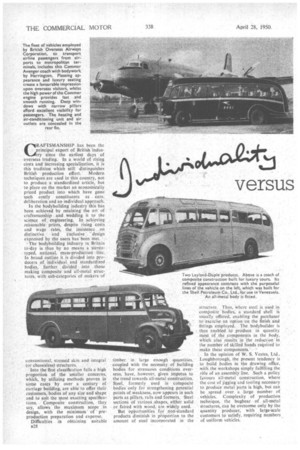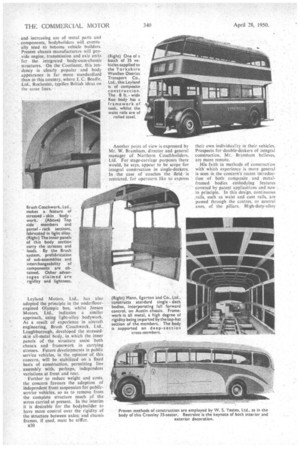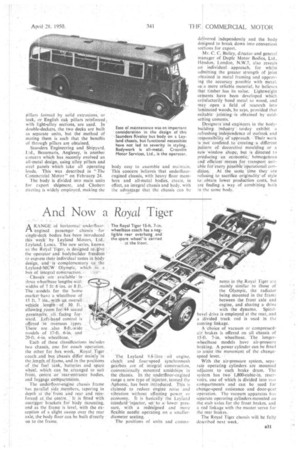STANDARDIZATION
Page 63

Page 62

Page 64

Page 65

If you've noticed an error in this article please click here to report it so we can fix it.
Bodybuilders, Compromising Between Traditional and Modem Qiiantity-prodUction Techniques, Retain the Essence of Craftsmanship in' TQ-da:■i's Methods CRAFTSMANSHIP has been the principal export of British industry since the earliest days of overseas trading. In a world of rising costs and increasing specialization, it is this tradition which still distinguishes British production effort. Modern techniques are used in this country, not to produce a standardized article, but to place on the market an economically priced product into which have gone such costly constituents as . care, deliberation and an individual approach.
In the bodybuilding industry this has been achieved by retaining the art of craftsmanship and wedding it to the science of engineering. In achieving reasonable prices, despite rising costs and wage rates, the insistence on
distinctive and exclusive; -design expressed by the users has been met.
The bodybuilding industry in Britain to-day is thus by no means a stereotyped, national, mass-production line. In broad outline it is divided into producers of individual and• standardized bodies, further divided into those making composite and all-metal structures, with sub-categories of makers of conventional', 'stressed skin and integral (or chassisless) structures.
Into the first classification falls a high proportion of the smaller concerns. which, by utilizing methods proven in some cases by over a century of carriage building, are able to offer their customers, bodies of any size and shape and to suit the most exacting specifications. Composite construction, they say, allows the maximum scope in design, with the minimum of preproduction preparation and expense.
Difficulties in obtaining suitable B28 timber in. large enough quantities,
• coupled with the necessity of building bodies for strenuous conditions overseas, have, however, given impetus to the trend towards all-metal construction. Steel; formerly . used in composite bodies only for strengthening potential points of weakness, now appears in such parts as .pillars, rails and formers, -Steel sections of yariotti shapes, either solid or faired with .wood, are widely. used.
But opporttinifies for' non-standard products diminish in proportion to the amount of steel incorporated in the
structure. Thus, where steel is used in composite bodies, a standard shell is usually offered, enabling the purchaser to exercise an option 'on the finish and • fittings employed. The bodybuilder is thus enabled to produce in quantity most of the .components in the body, which also results in the reduction 'in the number of skilled hands required to make these components.
In the opinion of W. S. Yeates, Ltd., Loughborough, the present tendency is to build bodies in the drawing office, with the workshops simply fulfilling the role of art assembly line. Such a policy favours all-metal construction, where the cost of jigging and tooling necessary to produce metal parts is high, but can be spread over, a large number of vehicles. Complexity of production technique, the bugbear of all-metal structures, can be overcome only, by the quantity producer, with large-scale customers to satisfy. requiring numbers of uniform vehicles.
Another spur to manufacturers ,of 'such designs is the export' field. Timber requires Stable conditions if it is to last, and these are not always foUnd on far-distant shores. Moreover, metal bodies, inherently more' rigid, lend themselves better to shipping -knocked down and to subsequent assembly, possibly by unskilled labonr.
Light-alloy bodies' eon-.
tinue to 'be considered ideal in many ways, particularly in view of the light weight and rigidity of the .resUlting structure. Welsh Metal Industries, Ltd., Caerphilly, is one of the few concerns making bodies largely of aluminium and duratumiti, although in this cast the floor, formed of heavrgauge aluminium skinning is laid bearers.
To prevent corrosion between the two materials. care must be taken in
the construction to passivatc them, the usual methods being to anodiie the aluminium and cadmium plate the steel, In the W.M.I. design the body is built up in sections, each composed of■interchangeable components. In this way _ repairs and maintenance of an alloy body are simplified, for the straightening of damaged sections and the welding of broken ones are not recommended unless carried out by skilled operatives.
As in other meW bodies, a large measure of jigging and tooling is essential to ensure economic production, and to make the quantities of spare parts for use in repairs.
Similar considerations arise in connection with stressed-skin and integral bodies now in production. So. far, the larger operator is best able to employ such designs, capable, as he is, of amassing resources as extensive as those of the manufacturer.
On the other hand, such developments have their particular part to play in the evolution of the passenger vehicle; they mark the end of the idea of dividing the vehicle into two sections, chassis and body, and the emergence of the concept of the unified structure, designed as a whole for carrying passengers over a variety of road Surfaces.
Logically, states Henhouse, Hartwell and Co., Ltd., Westhoughton, Lanes, a concern building composite bodies of modern appearance with a large • and increasing use of metal parts and components, bodybuilders will eventually tend tO betome vehicle builders. Present chassis manufacturers will provide engine, transmission and axle units • for the integrated body-cum-chassis structures. On the Continent, this tendency is clearly popular and body appearance is far more standardized • than in this country, where J. C. Beadle.
• Ltd., Rochester, typifies British ideas on the same lines.
Leyland Motors. Ltd., has also adopted the principle in the underfloorengined Olympic bus. whilst Jensen Motors, Ltd., indicates a similar approach,, using light-alloy bodywork. As a result of experience in aircraft engineering, Brush Coachwork. Ltd., Loughborough, developed the stressedskin all-metal body, in which the inner panels of the structure assist both chassis and framework in carrying stresses. Future developments in public service vehicles, in the opinion' of this concern, will be stabilized on a fixed basis of construction, permitting line assembly with, perhaps, independent variations at front and rear.
Further to reduce weight and costs. the concern favours the adoption of independent front suspension for publicservice vehicles, so as to remove from the complete structure much of the stress carried at present. In the interim it is desirable for the bodybuilder to have more control over the rigidity of the structure between axles: and chassis frames, if used, must be stiffer.
1330 Another point of view is expressed by Mr. W. Biamham, director and general manager of Northern Coachbuilders, Ltd. For stage-carriage purposes there would, he says, appear to be scope for integral construction in single-deckers. In the case of coaches the field is restricted. for operators like to express their own individuality in their vehicles. Prospects for double-deckers of integral construction, Mr. Bramham believes, arc more remote.
His faith in methods of construction with which experience is more general is seen in. the concern's recent introduction of both composite and metalframed bodies embodying features covered by patent applications and new in principle. In this design, continuous rails, such as waist and cant rails, are passed through the centres, or neutral axes, of the pillars. High-duty-alloy
Pillars formed 'by solid extrusions, or teak, or English oak -pillar§ reinforced with tight-alloy sections, -are used. In double-deckers, the •Isivo decks are built as separate units, bin the method Of mating them is such that the benefits of through pillars are obtained. Slunders Engineering and Shipyard, Ltd., Beaumaris, Anglesey, is another concern which has recently evolved an ail-metal design, using alloy pillars and steel panels which take all operating loads. This was described in "The Commercial Motor" on February 24. The body is divided into main units for export shipment, and Chobert riveting is widely employed,making the body easy to assemble and maintain. This concern believes that underfloorcngined chassis, With heavy floor members and all-metal bodies, create, in effect, an integral chassis and body, with the advantage that the chassis can he de ivered independently and, the body designed to break down into cOnvenient seLtions for export.
Mr. C. C..aitey, director and general manager of Duple Motor Bodies, Ltd., Hendon, London, N.W.7, also reveals an individual. .approach, for whilst admitting the greater strength of joint obtained in metal framing and approving the accuracy possible with metal. as a more reliable material, he believes that timber has its value. Lightweight cements have been developed which satisfactorily bond metal to wood, and may opena field of research into laminated woods, he saSAS, provided that suitable -jointing-his obtained by' coldsetting cements. Designers and engineers in the bodybuilding'. industry-, to-day exhibit a refreshing indePendence of Outlook and responsibility. of approath. -Their work isnot' Confined ,to 'creatinga• different pattern of: "decorative moulding or a new 'window shape: bu.t is directed to producing-an eco'noritic;' hOmogenous and efficient means for transport suitable icirevery possibie'Operatiortal condition: At the sarrie "time they. art refusing to sacrifice originalitr of style to obtain lower production costs, hut are tinding..a. way of combining both
in the same body. •




































































































































































































